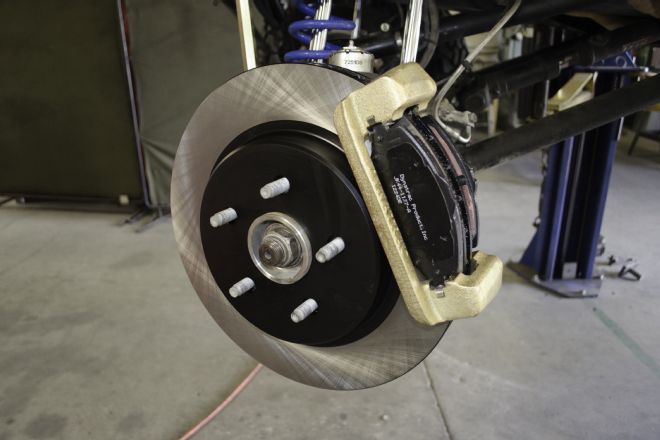
More than likely the brake system on that pickup truck or Jeep you take off-road almost every weekend is the last thing on your mind. On a daily basis, you are probably more concerned with gaining more power, improving traction, and upgrading the suspension of the vehicle.
Face it. You’ve added gobs of weight to the vehicle in the form of heavy duty bumpers, a winch, and any number of other assorted modifications. You have also increased the mass rotating at the ends of those axles with a set of custom wheels and huge tires. Now that rig isn’t as easy to stop on the trail as it was when driven off the showroom floor.
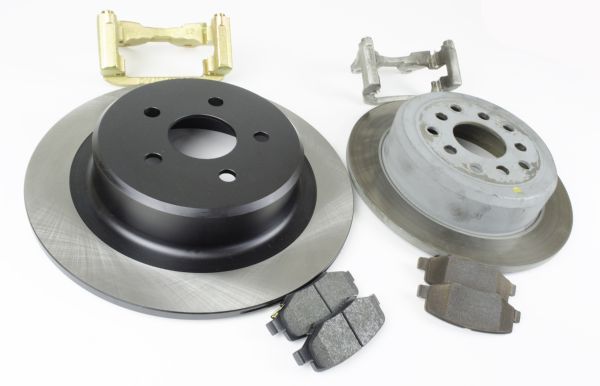 Upgrading to a larger rotor is always a good thing when it comes to increasing braking ability. The larger the rotor, the more rotor material surface, and therefore the greater ability of the rotor to absorb heat from the pad and shed it to the surrounding air, keeping brake fade to a minimum under hard and rapid braking events.
Upgrading to a larger rotor is always a good thing when it comes to increasing braking ability. The larger the rotor, the more rotor material surface, and therefore the greater ability of the rotor to absorb heat from the pad and shed it to the surrounding air, keeping brake fade to a minimum under hard and rapid braking events.
So what’s really important to look for when shopping for a brake upgrade? What are the myths, and what is good information? For this venture, we stuck to disc brakes, and took a look at a few primary points in brake system science to find out what’s important to know.
Swept Area
Swept area is something you see mentioned in specs when describing different disc brake systems. This is also known as pad annulus, or the area of the ring on the brake disc that the pad contacts (or sweeps) as the disc spins. While this is a good way to compare brake systems, it’s not the end-all-be-all to braking performance.
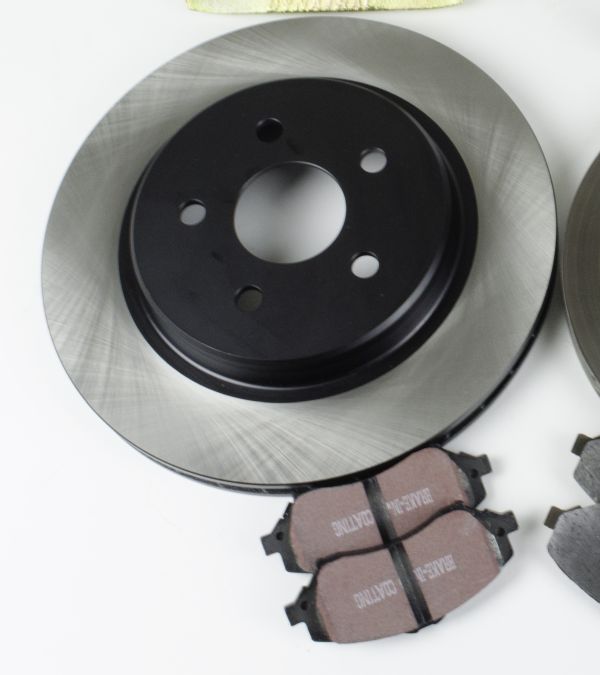 Swept area is not only a function of a larger rotor, but also a larger brake pad. A larger rotor may not necessarily mean a larger swept area, though as swept area can be limited by the space between the outside of the rotor and the brake hub (hat). A bigger pad will increase the amount of area the pad contacts the rotor and create a greater brake torque effective radius.
Swept area is not only a function of a larger rotor, but also a larger brake pad. A larger rotor may not necessarily mean a larger swept area, though as swept area can be limited by the space between the outside of the rotor and the brake hub (hat). A bigger pad will increase the amount of area the pad contacts the rotor and create a greater brake torque effective radius.
It's a simple method to partly quantify the rotor size. Brake engineers and racing teams use swept area as one of the measurements when building brake systems. However, just because an upgrade rotor is larger in diameter than the factory rotor, doesn’t necessarily mean it has a larger swept area. In many cases, swept area can be more a consequence of the limitations posed by the available space between the hub and the outside dimension of the rotor.
What can be considered more of a benefit from a larger swept area is the fact that the brake pad’s friction block is larger. A larger pad, whether it is wider or longer, will take longer to wear out or overheat. The larger pad can absorb more heat, and will take longer to reach its fade point. The other benefit to a larger pad face is that there is now a larger contact area between the pad and the rotor. This provides a bigger and better path for the rotor to be able to pull heat from the pad and dissipate it into the air.
The reason a large rotor, as well as increased swept area, is a good thing is that the larger the rotor, the larger the pad can be and therefor an increase in brake torque effective radius can be achieved. You really want both.
Vented vs. Non-Vented
Because a brake rotor is basically a heat sink, one of the major jobs that the rotor performs is to dissipate heat into the air in between braking. So unless you’re building a competition-specific vehicle for which overall weight reduction is preferred over longevity or cooling capacity, heavier vehicles, and vehicles that are subject to sustained high-heat intervals, will always benefit from vented rotors.
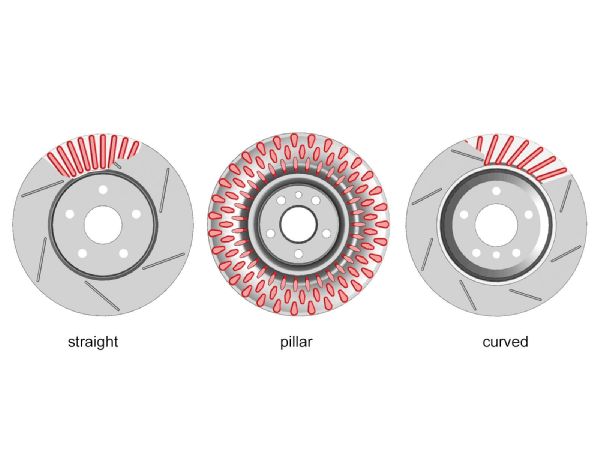 This illustration shows the difference between three types (straight, pillar, and curved) of brake rotor venting designs. The debate rages on about which is a better way to vent brake rotors, but what can’t be denied is that for almost any application, vented rotors are better than non-vented rotors.
This illustration shows the difference between three types (straight, pillar, and curved) of brake rotor venting designs. The debate rages on about which is a better way to vent brake rotors, but what can’t be denied is that for almost any application, vented rotors are better than non-vented rotors.
Venting increases surface area, and the effectiveness of a rotor to manage heat is a function of its overall mass and the total surface area. However, many times a heavier rotor with more mass can absorb the heat created in any given brake interval without rising to as high a temperature as a lighter rotor with less mass.
Some assume that the reason behind a directional vane as compared to a straight vane, or non-directional rotor, is because the directional vanes act as a small blower of sorts and help pump air through the rotor. This is to true to some extent true, but the real physics behind a directional vane’s ability to cool the rotor better is because directional vanes are normally longer than non-directional, and have more surface area. Again, more surface area equals greater cooling efficiency.
One of the biggest misconceptions about brake rotors is the affect of drilling holes in the rotors. We have all seen statements that drilling a bunch of holes in a rotor will make your brakes run cooler and stop faster. This is a myth. In almost all cases, when you drill holes through the rotor, mass is taken away and no appreciable surface area for the rotor to dissipate heat from is gained to make up for the loss of mass helping the rotor absorb heat from the pad. There is also less contact area on the rotor face for the pads to transfer heat to.
However, in some cases a swap to a larger and heavier brake rotor that has been drilled may not be a bad thing. For instance, if you are replacing a much smaller rotor (with a larger, heavier, and thicker rotor, then the gain in mass could outweigh (so to speak) the loss in rotor face surface area.
PhotosView SlideshowBrake Pad Materials
What’s the best brake pad? Well, there are something like 300 compounds that go into making a brake pad, so when you hear them called organic, ceramic, or metallic, it’s because that’s the primary ingredient in the pad’s composition. There are also carbon, carbon-ceramic, ferro-carbon, and semi-metallic brake pads. What you can be sure of about your choice of brake pads today is that none of them contain asbestos anymore.
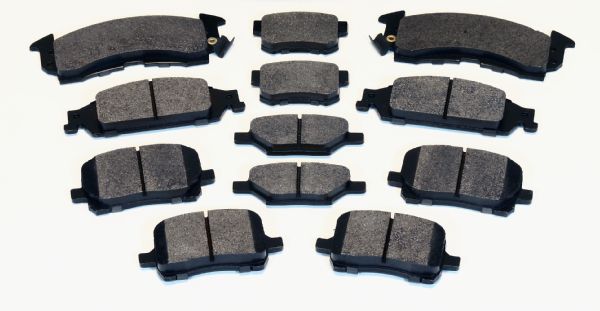 Brake pads come in a more sizes than a tree has leaves, and more material compounds than a rainbow has colors. One thing you can be sure of is that a larger pad of the same compound will almost always be better, and many of the industry experts we talked to suggested that semi-metallic was a good choice for much improved performance over OEM pads, while still maintaining an acceptable noise level.
Brake pads come in a more sizes than a tree has leaves, and more material compounds than a rainbow has colors. One thing you can be sure of is that a larger pad of the same compound will almost always be better, and many of the industry experts we talked to suggested that semi-metallic was a good choice for much improved performance over OEM pads, while still maintaining an acceptable noise level.
In the U.S., we mostly see ceramic in the aftermarket, and that is primarily due to the fact that they produce a light gray dust that is hard to see, and easy to clean off of the wheels (super important to many vehicle owners). They are also not as noisy as OEM (usually organic) brake pads.
Semi-metallic (or metallic composite) brake pads, for the most part, can provide a higher degree of friction than ceramics and higher resistance to temperature buildup that can cause brake fade and quicker wear. They are in most likelihood, a better choice for heavy vehicles that see hard braking, and they are also fairly good at keeping the noise down.
However, the most important thing to look for in an aftermarket brake pad is a brake pad’s “friction coefficient.” Higher friction number pads are going to be better performers. The trouble is that two pads of the same material from different manufacturers could have very different friction numbers.
An even bigger problem is that many brake pad manufacturers don’t list or won’t provide the friction numbers for a product. This can make comparison-shopping difficult, and it sometimes comes down to trying out a couple of brands until you find what works best for your application.
Moving Calipers Outward
The idea of moving the brake calipers (and essentially the rotors too) farther away from the center of the axle is another thing to discuss. Some brake upgrade kits do this, while others do not. The leverage arm created by the caliper to stop the wheel from turning is a function of the caliper’s pad centerline distance from the axle centerline. The longer the distance, the longer will be the leverage arm.
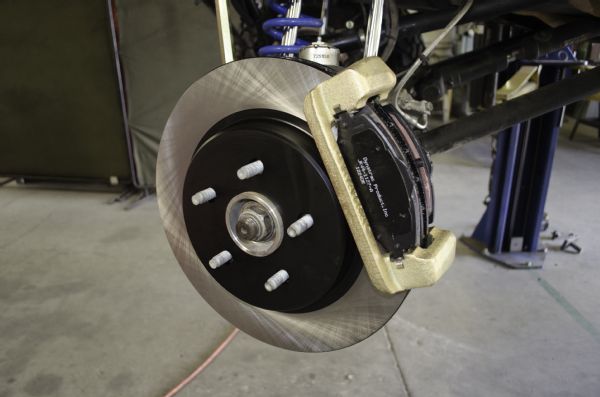 Some kits such as that from Dynatrac for the Jeep Wrangler JK deliver larger rotors, larger pads, and move the rotors farther out from the axle centerline. The closer you can get the caliper to the outside diameter of the tire, the more leverage it has to stop the wheel.
Some kits such as that from Dynatrac for the Jeep Wrangler JK deliver larger rotors, larger pads, and move the rotors farther out from the axle centerline. The closer you can get the caliper to the outside diameter of the tire, the more leverage it has to stop the wheel.
In very simple terms, the closer you move the caliper to the outside diameter of the tire, the more leverage it has to stop the wheel. This strategy works in consort with rotor diameter, and is the reason why putting the largest rotor on a vehicle that can fit inside the wheel is the biggest single factor to increasing brake torque.
Multi-Piston Calipers
The number of pistons in a brake caliper has nothing to do with determining the static hydraulic clamping force at the calipers. The clamping force is a function of total effective piston area. Whether you have a caliper with two pistons or six pistons on a side, if they both have the same total net effective piston area in square inches, the hydraulic clamping force at any given inlet pressure will be the same.
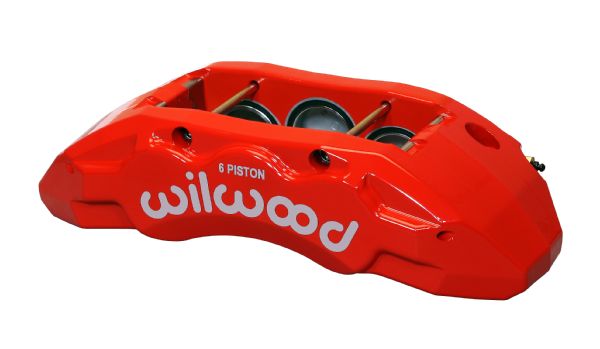 Multi-piston brake calipers do provide a definite advantage when upgrading the brake system on your rig, but it’s not because more pistons mean more clamping force–they don’t–unless they also provide greater net effective piston area. What multi-piston calipers do provide is more even pressure across the pad, which gives you positive pedal response, and more even wear over the life of the pad.
Multi-piston brake calipers do provide a definite advantage when upgrading the brake system on your rig, but it’s not because more pistons mean more clamping force–they don’t–unless they also provide greater net effective piston area. What multi-piston calipers do provide is more even pressure across the pad, which gives you positive pedal response, and more even wear over the life of the pad.
Upgrading to multiple-piston calipers can provide a braking improvement in a different way, and it all relates to efficiency. First, a caliper with multiple pistons over the length of the pad, as opposed to one single large piston over the length of the pad, will deliver that clamping force in a much better and balanced loading of the pad against the rotor. The benefits of multiple-piston calipers are typically a more confident and positive pedal response, and more even wear over the life of the pad.
Secondly, making a caliper with multiple small pistons that spread their clamping force out over the length of the pad, instead of a single large piston in the center, makes it easier for the caliper manufacturer to build a more rigid caliper with less bulk. The rigidity (or resistance to flexing) creates a much more positive pedal response, offers less wasted pedal travel by minimizing deflection, and more evenly loads the pads. All of which add up to better overall brake performance.
Building Better Brakes
So when building up your off-road truck or that Jeep, we agree that it’s a good idea to pay attention to creating a suspension system that is ideally suited for handling the type of terrain that you want to challenge and your driving style. Absolutely push for more power.
Accessorize and modify your rig with whatever mechanical tools it takes to live out your off-road dream. Just don’t forget the brake system. There’s nothing worse than finding out that you can’t stop having all the fun when all of sudden a tree moves into the middle of the trail.
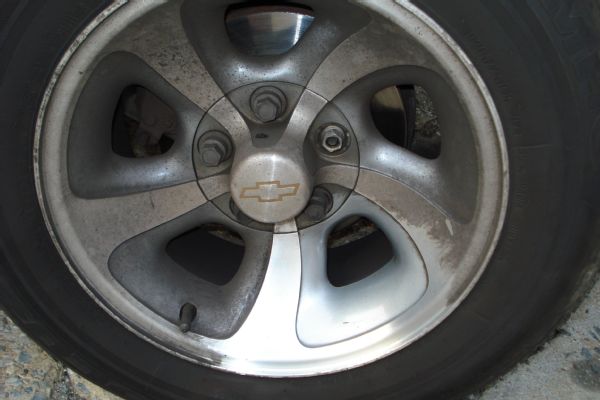 One of the best reasons to, at the very least, upgrade the OEM pads in the brake system on your rig is the huge decrease in brake dust. While even OEM pads (usually organics) no longer contain asbestos, they do create a dark black dust that can be difficult to clean from wheels. Ceramic and semi-metallic pads also produce dust, but they create less, and it’s light gray and easier to clean up.
One of the best reasons to, at the very least, upgrade the OEM pads in the brake system on your rig is the huge decrease in brake dust. While even OEM pads (usually organics) no longer contain asbestos, they do create a dark black dust that can be difficult to clean from wheels. Ceramic and semi-metallic pads also produce dust, but they create less, and it’s light gray and easier to clean up.


